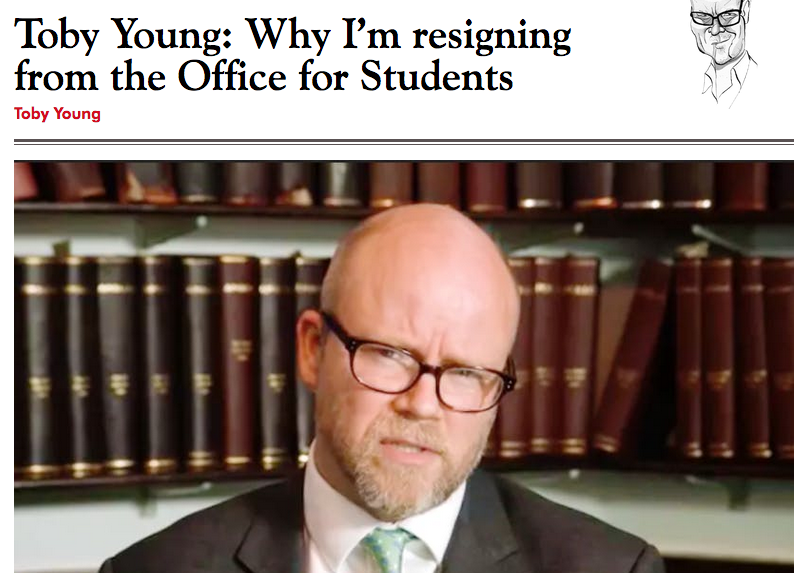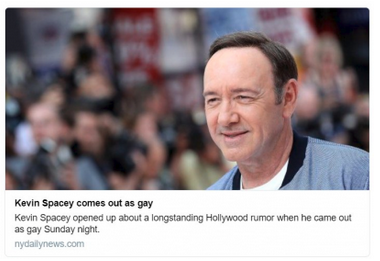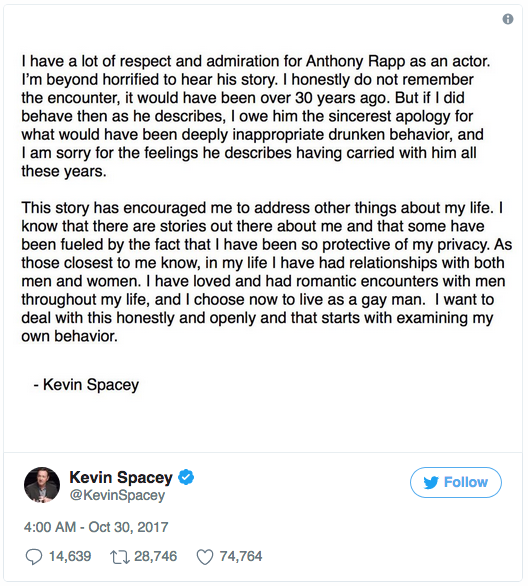-
Toby Young, Spiked, Katie Hopkins and how stupid stopped being the new clever
Being rude, crude, un-fact-checked, or even downright offensive had, until recently, been the path to power and influence for those using the media to build a career.
Katie Hopkins was top of the columnist pile, Nigel Farage had Question Time as his own and little Toby Young was appointed by a chum to a government post to stir up the lefties and the oiks.
Only no one reckoned with the fallout from the Trump presidency and the subsequent Weinstein A-Bomb. Suddenly, being a pub bore was no longer a desirable character trait. Twitter would call you out and may not stop until you were fired.
People were pointing. shouting and then laughing. Katie wound up being ditched by LBC and the Daily Mail, Nigel moaned about being skint and Toby was forced to resign.
Even Spiked, the online magazine for economically liberal Tories who used to be communists but now like public schools and dinner parties, has seen its commentators and its manufactured ire largely ignored. They still let them review the papers, which is nice, because they’re nostalgic about the print industry, inky-fingered sons of toil and that young woman that they got off with at the Wapping dispute picket line.
So far, so good, you may say. But what this marks is a change in the way that ideas can and will be communicated. I am not holding out for a return to a fictional golden age of journalism. But things will alter. Thinking of the prevailing decent view and then positing the opposite doesn’t play so well any more. You need to be cleverer than that.
But it is not only journalists who need to beware of potential pitfalls. Those looking to promote and sell need to be aware too. For example, Poundland just about squeaked through with a Marmite-y Elf on the Shelf Twitter campaign over Christmas. But they were derided as much as they were applauded for it.
Similar stunts, humour or even ads will need to walk a fine line between grabbing the attention and grabbing your crotch in a crowded park. The bold and the clever will know. You can be controversial or edgy without being, to put it bluntly, a wanker.
But not everyone knows when they are being a wanker. Hence Toby Young.
-
Content quality or content quantity?
A new client recently asked me why they should hire me when they could probably get three content farmers from a freelance-for-hire site for the fee I was asking for.
Good question. Here’s the answer. And yes, they hired me.
Content is a question of quality AND quantity. That is not to say that you can’t do well in searches with a LOT of fairly average content. It’s probably a good idea if you don’t have a lot to spend, or a lot to say. But sub-standard or dull copy won’t do a lot to enhance your brand once those Google users reach your website. And it won’t help you when Google shifts the goal posts, again. In fact, it could well work against you.
In explaining, I cited a previous client who had a fantastic amount of fairly dreadful content. This was packed with keywords, links, relevant information and even useful pages. The problem was that it looked like it had been delivered by a dumper truck. It was dull, it was jumbled and it was not something you could enjoyably read. This was content as landfill.
But Google decided it was even worse than that. They de-listed the entire site.
This was when the client came to me.
Building a brand with content
We slowly began to build quality content, with blogs, news and quality content in long form. We went back to the pre-web basics of creating something that people wanted to read. After all, that is the point of creating communications. Too many content managers worry more about their search engine readers than their human ones and that is a mistake.
With a new content plan in place, and with readable copy on the site, we started to attract readers via a press campaign, giving away content and creating more that was enjoyable and informative. Before long, Google was re-listing the website, the national press were picking up on stories we created and the CEO was appearing as a commentator on the industry on news programmes.
This had not happened before. But then the CEO did not have an authoritative voice and a platform for it before. All a journalist would see would be a whole lot of listings, noise and babble. So, for an outlay that was being made anyway, I added the bonus of a media profile. He was an easy sell, as he knew all about the business. You could see it in his (my) words.
With this all in place, the platform grew and the content kept coming. Some from me, some from other quality contributors. We could have added some lesser quality content at this point (and it may have helped with SEO), but the CEO wanted to keep his strong voice across the site with good content.
This was a good call, as the offers for the business started to come in, which was what the CEO wanted all along. Now people could see the quality and the potential. Previously, they couldn’t even Google it.
Before too long, the business was sold.
Job done.
-
How Kevin Spacey changed crisis PR forever
Kevin Spacey’s PR team must have been initially pleased with themselves as the story broke over his alleged sexual assault of a a then 14-year-old Anthony Rapp. Their client was accused of pretty much the worst thing you can be accused of, yet the initial headlines were about Kevin Spacey coming out as a gay man.
Spacey’s team had time to strategise, write and re-write, prepared by months of rumour and some solid Twitter accusations. They then waited for the bomb to drop, ready with their own even larger ammunition, which would pack an even bigger bang. Spacey’s sexuality was barely a secret any more, but they knew that this was still a huge story about a much-loved and respected actor.
Initially, this strategy worked. Sexual assault was not in the headlines or the opening paragraph in many stories on major news networks and newspaper websites. Instead, we were presented with an actor struggling with his identity and sexuality. The assault was dismissed as a drunken incident. Insignificant and long-since forgotten.
But this is 2017. Comment is instant and networks can gather and react fast. Within minutes of the headlines, Twitter was awash with condemnation of the strategy.
Spacey had tried to conflate his actions with his sexuality. This was a step too far for commentators who had seen this kind of thing in the 1970s and 1980s, when the tabloid press was only too willing to confuse being gay with being a pederast or paedophile. Similarly, younger LGBTQI tweeters were dumbfounded by Spacey’s conflation.
In short, this was a very short-term win that turned into a long-term disaster and a lesson in how not to do disaster PR in 2017. The centre held. But only for about 30 minutes. This was a landmark in public relations. A tipping point. This was the day that everyone could suddenly smell bullshit.
It wasn’t long before journalists and columnists could smell blood over this rather unpleasant stench, with everyone from the Sun to the Guardian publishing columns slating Spacey’s tactics. The picture in the US media was much the same.
Before too long, Netflix was distancing itself from Spacey and others were following. The strategy had not only failed, it had spectacularly backfired. Within hours, people were speculating as to just how much Spacey was like his character Frank Underwood in House of Cards. After all this was almost an Underwood play. ‘There’s no better way to overpower a trickle of doubt than with a flood of naked truth.’
So far so bad for Spacey, but this was a sea-change moment in PR too. The public have already become accustomed to President Trump dropping bombs (sometimes literally) to deflect attention away from a crisis, with Spacey’s team illustrating how that works outside the Whitehouse. Much active crisis management from PRs will now result in them being called out for ‘doing a Spacey’, damaging both agency and client alike.
New ideas and new strategies will now have to be called upon in even the smallest crisis where saying nothing and going on a long holiday is not an option. PR now has its own crisis to manage, which could easily snowball. To quote Francis Urquhart (the original House of Cards lead in the 1990 UK version): ‘Nothing lasts for ever. Even the longest, most glittering reign must come to an end some day.’
-
Modern day mining
“Have you got all this in a spreadsheet?”
This is often my question upon arriving at a business and a new client tells me all about their customer base.
I hate spreadsheets.
Most often, the answer is ‘no’. Most often this answer comes from a business that does a good degree of business online and most of it via a computer in some way or other.
This is the wrong answer.
The beauty of modern business is that it comes with a slew of data. Companies such as Google or Facebook made their fortunes realising how valuable that is to enable them to sell things. Some businesses realise this. But very few realise that data mining is hugely valuable for ideas and for marketing.
There are stories in there.
I am terrible at science, but there should be a formula that goes something like Data X x Data Y + Interesting correlation = story. It is simple PR stuff.
Let’s imagine a stationery business. Most red pens are sold in Nottingham. Most blue pens are bought by men aged 55-59. No men have ever bought a green pen. Women buy 75% of pencils sold. Millennials purchased 200% more paper than in previous years. You get the idea.
These are all story starters that someone creative could turn into headlines. It doesn’t take much. But it does take a good eye for facts and for the media mindset. It also takes skill to know what to do with the data you are mining and how to represent it.
There is another way to do this too. This requires slightly more skill and insight into the sort of business you are dealing with. Whereas browsing spreadsheets is like mining an established seam, this is like digging a hole not knowing what is there. Or, to put it more simply, it is guesswork.
Working backwards, I conjure up data-led stories that would work for the company in question and then see if the numbers can back it up. It helps if you have a really good data or programming person onside in the business.
If the numbers don’t exist, then you can always make them.
I don’t mean by lying. Although some may be tempted.
Just look at advertising for how this works. You create the story. So, most professional novelists use our red pens. Most cancer surgeons use green felt tips. Most cartoonists use Brand X pencils.
Note, it does not say ‘buy’. If you send every professional novelist in the UK a red pen then chances are you can survey them and ask ‘did you use that?’ If 51% say yes then your claim is true. 8/10 ad men and women say they prefer to do it that way. Watch the ads and pay attention next time you see a usage statistic.
Everyone uses a freebie. Especially if it is something they are likely to use anyway.
-
Take notes, they could just be everything
I am often asked for the one tip that I would give to writers, journalists, copywriters and, well, just about anyone who writes. My answer is always the same, whether you write for a living or for fun. Take notes. Get a notebook. Fill it. Then fill another one. And so on.
90% of what you write down will be irrelevant at best and incomprehensible at worst. Those who take notes religiously know only too well the feeling of going back through their notes and wondering just who the hell wrote them. Was it a maniac? A spider? A fool? But they also know that these books can turn up gold when you go back to them before boxing them up for posterity or to simply save space.
Note-taking is an essential for anyone who uses ideas and imagination in their day to day life. Ideas are fleeting. You have to catch them before they go. No matter how crazed they sound. Many people have multiple notebooks: one in their work bag, one on their desk, one by the sofa and one by the bed. Inspiration can strike anywhere and at any time. So you need to be ready.
Does it matter what sort of notebook you use? Well, yes and no. A 99p reporter’s pad is just as useful as a top of the range leather-bound journal when it comes to taking notes. But notebooks can impart both care and character, as author Paul Auster is only too aware. After all, you may well look after a £10 notebook better than a £1 one. You may even feel more confident taking it out in meetings or when you are out and about. But whichever works for you is fine. Something with a page marker can be great, as you can automatically go to the next blank page without a fuss.
What do I use? Well, I have boxes of different notebooks in the attic. From the cheap or giveaway to Moleskine journals.Nowadays, I keep one hardback Moleskine for meetings and away days, with smaller Moleskine paperbacks for fitting in a pocket. More importantly, I have gone electronic in the last few years.
It may sound like a cult to those who don’t use it, but I am fully committed to Evernote. I can take notes on my phone and sync them across devices, with a back up kept permanently online and offline. This means I can go back to notes at any time (without digging in the loft) and I can search my notes by key words or themes. New projects mean a new notebook, which can just sit with the rest on my phone or laptop.
I have a pro account (and I am not being paid for this), but have not yet gone as far as buying Evernote-enabled Moleskine notebooks. Although I do browse the Evernote blog every now and again, discovering gems such as how Siri can now make an Evernote note.
Try it if you have a smartphone. You have nothing to lose but your need to find a pen when you have an idea.
But whatever you do, do keep taking notes. Once you finish a notebook spend an hour or so reviewing it. There may be missed gems in there, or rejected ideas that could now have their time. I was once described as someone who is three years ahead of his time in terms of ideas, so I am always sure to go back and check once the world has caught up.
Those un-useable or out there ideas may be at the very forefront of fashion or thinking right now. It’s like having my work already done.





